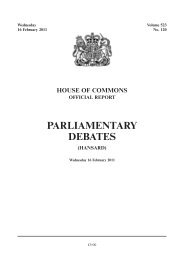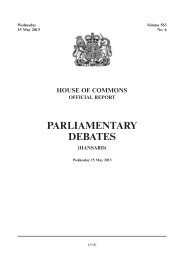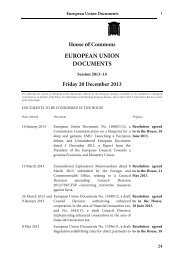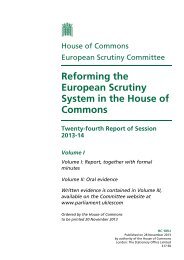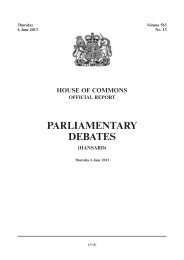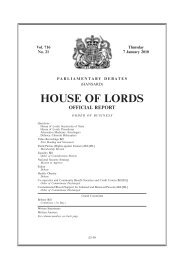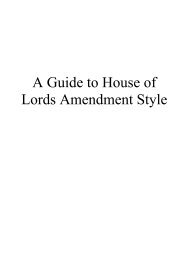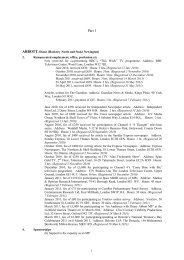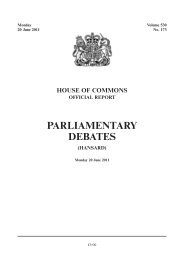Ticketing and Concessionary Travel on Public Transport - United ...
Ticketing and Concessionary Travel on Public Transport - United ...
Ticketing and Concessionary Travel on Public Transport - United ...
Create successful ePaper yourself
Turn your PDF publications into a flip-book with our unique Google optimized e-Paper software.
14 November 2007 Mr Chris Austin, Mr David Mapp <str<strong>on</strong>g>and</str<strong>on</strong>g> Mr Richard Malins<br />
Q36 Mr Scott: You say, underst<str<strong>on</strong>g>and</str<strong>on</strong>g>ably, that the<br />
Government’s c<strong>on</strong>cessi<strong>on</strong>ary fares policy <strong>on</strong>ly looks<br />
at <strong>on</strong>e mode of transport <str<strong>on</strong>g>and</str<strong>on</strong>g> does not c<strong>on</strong>sider rail<br />
services, but that extending it to rail services would<br />
need careful thought. Can you see a sensible nati<strong>on</strong>al<br />
extensi<strong>on</strong> of free c<strong>on</strong>cessi<strong>on</strong>ary fare schemes that<br />
would include some rail journeys without incurring<br />
high costs or overloading already busy trains?<br />
Mr Austin: I think that is a very diYcult thing to do<br />
because it is quite diYcult to distinguish between<br />
short distance <str<strong>on</strong>g>and</str<strong>on</strong>g> l<strong>on</strong>g distance travel. They tend to<br />
share the same trains, for example between Coventry<br />
<str<strong>on</strong>g>and</str<strong>on</strong>g> Birmingham <str<strong>on</strong>g>and</str<strong>on</strong>g> Macclesfield <str<strong>on</strong>g>and</str<strong>on</strong>g> Manchester,<br />
<str<strong>on</strong>g>and</str<strong>on</strong>g> you have shorter distance passengers using<br />
l<strong>on</strong>ger distance trains. The worry would be for us<br />
that whilst we would welcome the extra business,<br />
providing it was properly paid for, the experience<br />
with the bus industry is that it has led to c<strong>on</strong>siderable<br />
overcrowding. We already have a lot of<br />
overcrowding that we are tackling <strong>on</strong> the rail system<br />
at the moment so if that were to be the case, <str<strong>on</strong>g>and</str<strong>on</strong>g> to<br />
encourage a lot of additi<strong>on</strong>al oV-peak traYc, we<br />
would need support to enable us to exp<str<strong>on</strong>g>and</str<strong>on</strong>g> the<br />
capacity of the rail network to cope with it.<br />
Q37 Mr Hollob<strong>on</strong>e: To follow <strong>on</strong> from Mr Scott’s<br />
point about the Oyster card <str<strong>on</strong>g>and</str<strong>on</strong>g> the diVerential<br />
charging for cash <str<strong>on</strong>g>and</str<strong>on</strong>g> Oyster, in your answer, Mr<br />
Mapp, you said under the current regulatory<br />
framework you are not allowed to diVerentiate the<br />
price. Will that be the case then when the ATOC<br />
companies introduce the Oyster card in L<strong>on</strong>d<strong>on</strong>?<br />
Mr Mapp: At the moment I am not aware that the<br />
DfT plans to make any specific change to the<br />
regulatory framework to allow for that. I think it is<br />
true to say that we have argued the case with the DfT<br />
for there to be greater freedom with regard to pricing<br />
<str<strong>on</strong>g>and</str<strong>on</strong>g> indeed for us to be given the ability to<br />
diVerentially price, by which means we will be able<br />
to do that. Whether in the c<strong>on</strong>text of Oyster<br />
introducti<strong>on</strong> we would choose to then introduce a<br />
similar pricing regime to that introduced by<br />
<strong>Transport</strong> for L<strong>on</strong>d<strong>on</strong>, I think is a questi<strong>on</strong> that we<br />
have not fully addressed.<br />
Q38 Mr Hollob<strong>on</strong>e: As it st<str<strong>on</strong>g>and</str<strong>on</strong>g>s at the moment there<br />
would be a substantial diVerence between a<br />
passenger in L<strong>on</strong>d<strong>on</strong> <strong>on</strong> an overground train <strong>on</strong> <strong>on</strong>e<br />
of your companies where there would not be a<br />
financial penalty incurred, as <strong>on</strong> the L<strong>on</strong>d<strong>on</strong><br />
Underground at the moment, in buying a ticket for<br />
cash?<br />
Mr Mapp: That is correct.<br />
Q39 Mr Hollob<strong>on</strong>e: With regard to fare dodging, is<br />
it right that you think that nati<strong>on</strong>ally the loss of<br />
revenue from fare dodging amounts to some £400<br />
milli<strong>on</strong> or about 8% of revenue?<br />
Mr Austin: That is the figure that we put in our<br />
paper. I would say that it is an informed guess, an<br />
informed estimate. There is no c<strong>on</strong>sistent across-theboard<br />
survey of this although individual train<br />
companies do research it <strong>on</strong> a regular basis. It is our<br />
best estimate of what it is likely to be.<br />
<strong>Transport</strong> Committee: Evidence Ev 5<br />
Q40 Mr Hollob<strong>on</strong>e: Is that not an excessive amount<br />
that could go into improving the public transport<br />
system? Given that you are having to make a guess<br />
of what that amount is, should data not be collected<br />
far more comprehensively given the scale of the<br />
problem?<br />
Mr Austin: I think the answer is yes to both of those<br />
questi<strong>on</strong>s. It is a lot <str<strong>on</strong>g>and</str<strong>on</strong>g> train operators are doing a<br />
lot to address that, both through gating additi<strong>on</strong>al<br />
stati<strong>on</strong>s <str<strong>on</strong>g>and</str<strong>on</strong>g> through providing higher levels of<br />
ticket checks <strong>on</strong>-train, which overcomes the<br />
shortcomings of the gates. In the process of doing<br />
this, they are also building up a much better store of<br />
informati<strong>on</strong> <str<strong>on</strong>g>and</str<strong>on</strong>g> time series data to dem<strong>on</strong>strate<br />
much more accurately the level of losses being<br />
incurred, so the two really go together.<br />
Q41 Mr Hollob<strong>on</strong>e: I think that Mr Malins is of the<br />
view that there is an over-reliance in the rail industry<br />
<strong>on</strong> introducing barriers to prevent fare dodging <str<strong>on</strong>g>and</str<strong>on</strong>g><br />
more sophisticated strategies are needed. Mr<br />
Malins, would you elaborate <strong>on</strong> that?<br />
Mr Malins: My point here that I put in the paper,<br />
<str<strong>on</strong>g>and</str<strong>on</strong>g> I repeat for you now, is that, first of all, as Chris<br />
has admitted, there is no sound or c<strong>on</strong>sistent method<br />
of measurement by most TOCs <strong>on</strong> the extent to<br />
which they have fare evasi<strong>on</strong> or simply ticketless<br />
travel, what I would describe as people who may not<br />
pay their fares for the very reas<strong>on</strong> the Committee<br />
was alluding to earlier <strong>on</strong>, that it is actually quite<br />
diYcult to buy a ticket in the first place. So we need<br />
to distinguish between people who are deliberately<br />
trying to avoid paying <str<strong>on</strong>g>and</str<strong>on</strong>g> those who find it diYcult<br />
to pay because the facilities are not there. The sort<br />
of numbers that Chris has been talking about would<br />
embrace absolutely everything if the number were<br />
correct—<str<strong>on</strong>g>and</str<strong>on</strong>g> I suspect it might be <strong>on</strong> the high side.<br />
Q42 Mr Hollob<strong>on</strong>e: Whilst you are <strong>on</strong> the subject of<br />
whether people are genuinely dodging fares or<br />
accidentally dodging fares, do you have any estimate<br />
of the number of people who are willfully doing this?<br />
Mr Malins: All I can say is that <strong>on</strong>e can draw a little<br />
pie chart which says if you look at the world at large<br />
there are people out there who always want to pay<br />
their fares <str<strong>on</strong>g>and</str<strong>on</strong>g> are committed to doing it. That could<br />
be 80% of the populati<strong>on</strong> but it will vary <str<strong>on</strong>g>and</str<strong>on</strong>g> I would<br />
not like to say that is an absolutely correct figure.<br />
Then there are people who if it is made diYcult to<br />
pay they will not bother. Then there are people who<br />
are determined fare evaders. Quite what number<br />
they represent is something that is very diYcult to<br />
get at. I would say that the number Chris quoted is<br />
probably an outside number for fares not paid for all<br />
sort of reas<strong>on</strong>s, some of them in fact not the<br />
customers’ fault. I do not think there is any<br />
c<strong>on</strong>sistent measurement within that to know<br />
precisely what the number is <str<strong>on</strong>g>and</str<strong>on</strong>g> therefore what the<br />
reas<strong>on</strong>s are <str<strong>on</strong>g>and</str<strong>on</strong>g> how best to tackle them. The point<br />
I was making to the Committee is I think it is a kneejerk<br />
reacti<strong>on</strong> by train operating companies to revert<br />
to closing stati<strong>on</strong>s, which is the system we had years<br />
ago, which meant people were st<str<strong>on</strong>g>and</str<strong>on</strong>g>ing around<br />
getting bored so that we can check people at the<br />
beginning of the journey. The sort of gates that are



